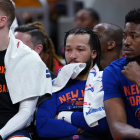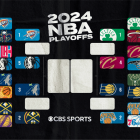On Saturday, the Clippers and Wizards played a game that went down to the wire, but all anybody could talk about once it was over was the absurdity of everything that happened in the final 30 seconds.
With the Wizards leading, Los Angeles slowly fought its way back into a one-possession game and had a chance to tie or take the lead. Austin Rivers caught the ball on the perimeter, and without conscience, fired up a shot to take the lead. He missed, but the Clippers grabbed their own rebound and fed Rivers again. He didn't disappoint this time.
Bang-Bang-Bang! #PrimeTicket pic.twitter.com/B7atCgthxG
— LA Clippers (@LAClippers) December 9, 2017
This led to a potential game-winning scenario for the Wizards with Scott Brooks drawing up the play. Those who have watched Brooks' teams for a long time were likely expecting an isolation hero ball type set his teams are more known for, but no. The Wizards drew up a gorgeous play out of the timeout that left Bradley Beal nothing but open lane to the rim.
Nicely run by the Wiz to take the lead back on Beal's +1 pic.twitter.com/kCHNkTNAES
— CJ Fogler (@cjzero) December 9, 2017
They say the inbounder can be the most dangerous player on the court and that's what Beal was here. He fakes toward Gortat as if he's going for a hand-off play on a screen, but instead he bolts back toward the rim with nothing but court ahead of him on his way to the rim. Then he uses contact to create an and-1 situation forcing the Clippers to tie if they go for two.
What follows is insanity. The Clippers run a set to burn clock and Lou Williams goes full hero ball on a 3-pointer he shoots from Hollywood distance.
7th 20-point game off the bench for .@TeamLou23, tied for most in the @NBA. 💪 pic.twitter.com/cWGfPM303p
— LA Clippers (@LAClippers) December 9, 2017
This left the Wizards with 1.2 seconds remaining. Enough time to catch the ball and maybe dribble once before shooting. The Wizards once again went to Beal and they found him baseline. He caught the ball away from the rim, dribbled, but before he could shoot the buzzer went off. He made the basket. Beal immediately demands a review even though he was clearly late.
First, once again Brooks drew up a good out of bounds set to get Beal a better look than just a catch and shoot. However, the clock operator must have thought a Clipper made contact with the ball before he caught it so the clock started early. This resulted in Beal not having enough time to get his shot off.
The refs did review the play, and when they came back they decided to drop the clock to 1.1 seconds of time and move the spot of the inbounds. This decision was a little odd. Couldn't they have timed the play to see if, had the clock started on time, Beal would have gotten it off on time? Even if that's not allowed, or impossible to do, why restart the play from a different spot with less time left?
The logic here is most likely that, because the clock started early, the refs have no way of determining how much of the play was affected. So they chose to re-start the game from where it would have continued around where Beal caught the ball. It's odd, but there's some sense to it. Unfortunately for the Wizards this left them in a worse position, with slightly less time. Whatever play they designed was blown up by Los Angeles before the ball was even inbounded.
To take a guess, the play design was probably a lob somewhere near the basket, and when there was no lane available the cutter would move back towards the perimeter and shoot on the catch. However, nobody on the Wizards was able to create separation on the play resulting in a contested Marcin Gortat prayer shot.
After the game, a pool reporter asked referee Bill Spooner why the clock and inbounds were placed where they were.
Referee Bill Spooner said the clock should have been set to 0.1, and that the refs made an error by reseting it to 1.1. “We had a clock malfunction early start.” Said ball was inbounded at “point of interruption,” which is where Beal caught the ball. (more)
— Todd Dybas (@Todd_Dybas) December 10, 2017
Spooner said the rule enforced is Rule 13 section 1A-5.
— Todd Dybas (@Todd_Dybas) December 10, 2017
I followed up with Spooner to be sure I understood the reset to 0.1.
“The wasted time, if you will, the time that they lost was 1.1. With an inbounds of 1.2, that leas, mathematically, 0.1…"
To make everything even more confusing. The Wizards actually should have had even less time than where they were and the inbounds placement was correct. The rule section Spooner was referring to, Rule 13 section 1A-5 is on the matters of what play can be reviewed. It says.
a. Instant replay would be triggered in the following situations: (1) A field goal made with no time remaining on the clock (0:00) at the end of any period.
The only explanation I can think of that makes sense for this is that the refs did in fact measure the amount of time Beal lost while attempting his shot in comparison to the play clock. Which, if that's the case, wouldn't that mean his basket should have counted and it was actually Clippers ball with .01 seconds left? Although, an argument could be made that the Clippers stopped playing proper defense once the buzzer sounded.
This entire situation is hard to explain. Personally, I'm glad the refs chose to put 1.1 on the clock as opposed to 0.1, because the explanation of giving the Wizards the ball where Beal caught it and continuing the play from there makes more sense than the explanation on how the Wizards wasted 1.1 seconds of time.






















